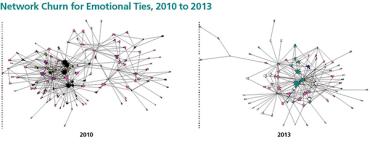As every educator knows, it’s important who your colleagues are—fellow teachers and principals alike. After all, relationships with colleagues shape so much of what goes on in schools. Over time, these interactions transform into what researchers call formal and informal networks; it is through these networks that learning takes place, as educators interact with one another, exchanging knowledge, advice, and professional support and engaging in friendships. The strongest of those social ties are grounded in trusting relationships, which are the cornerstone of productive human relations.
Indeed, much has been written about how positive relationships, by their very nature, involve a high level of reciprocal trust developed and earned over time.1 Trust is based on interpersonal interdependence2 and involves an individual’s or group’s willingness to be vulnerable to another party based on the confidence that that party is benevolent, reliable, competent, honest, and open.3 High levels of trust have been associated with a variety of efforts that require collaboration, learning, complex-information sharing, problem solving, shared decision making, and coordinated action4—the very types of efforts that occur daily in high-functioning organizations (including schools).
When we interact with others in our networks, we assess “risk” in terms of how they might react. Over time, with repeated positive interactions, our level of trust increases and our caution concerning risk decreases. Individuals can interact more effectively with high levels of trust. Consider how you and a work colleague might have a shorthand for communicating and acting; it is trust that allows for this efficiency. Moreover, when you have a high-trust relationship with someone, you are more likely to share your struggles, and it is in that moment of vulnerability with a close colleague that some of the best learning happens.
The back and forth exchanges between individuals in the process of developing trust are referred to as “reciprocal relationships.” In reciprocal relationships, each person contributes to the other; these relationships provide opportunities for individuals to interact, learn together, and build trust, critical components in education systems oriented toward change.5
The opposite is true in networks where individuals come and go. When there is what we call “churn” among colleagues, opportunities for trust and reciprocal interactions can’t fully develop, and the risk or cost of interacting increases significantly.
Ultimately, the social and economic costs of churn are deeply intertwined. For instance, when someone who’s a trusted colleague, key listener, helpful resource, friend, or confidant leaves a school, that departure creates a hole that’s hard to fill. The departure can involve a loss of knowledge, social support, and institutional memory. Moreover, it can create a sense of instability and disrupt routines, which in turn can lead to a loss of productivity. These are very real social costs associated with turnover in schools and districts—in addition to the financial expense in terms of training and development.
By and large, research has focused more on the departure of teachers and has overlooked the fact that central office leaders and principals also leave school districts at high rates, especially in large urban districts. This oversight is important to highlight for several reasons. First, we know that educational leadership matters for educational improvement.6 Second, research suggests that it takes about five years for education reforms to take hold.7 Third, absent district leadership, churn can potentially have a cascading disruptive impact, from the superintendent’s office all the way to the classroom. Our research attempts to broaden understanding about leadership churn and how it affects the entire school system.
In an era of multiple education reforms, administrator churn, particularly at the district office, can disrupt educational priorities and initiatives and cause classroom teachers to adopt the mentality of “this too shall pass.” At some point, most teachers have wondered, “How long will this approach last?,” “What will be the new focus?,” or “Who will be in charge next and what does that mean for my school?” Anyone who’s been in education even a short time knows that change at the top can change life in the classroom, and constant change can make teachers want to hunker down and wait things out.
The anxiety and concern caused by administrative churn can take enormous time and energy, moving the focus away from creating the conditions to support teaching and learning. Moreover, classroom teachers are often given conflicting messages about what they, their school, and their district should prioritize. This is a reality that many teachers, particularly those in urban schools, face frequently. Given the ubiquity of this experience for educators across the country, we wanted to better understand administrator churn and shine a light on how system disruption can take the work of education in some not-so-promising directions.
In this article, we argue that studying churn among central office leaders and school principals can improve retention of high-quality leaders who can better support teachers.8 To be clear, we are not saying that all churn is negative. In fact, some turnover can be healthy and healing to relationships and wider communities. However, constant churn often means that initiatives barely have the opportunity to get off the ground before a new central office administrator or principal comes on board and rolls out a different approach. In essence, constant churn at the leadership level has a significant social cost that affects teachers on multiple levels.
To study administrator churn, we use social network theory, a core aspect of which is social capital. Social capital is concerned with the resources that exist in relationships between individuals.9 The ability to access relationships with others and the quality of those relationships often determine opportunities for success. Networks can be seen as the patterned structure of relationships that exist within a particular organization or group. To make this come to life in an educational setting, we use a technique called social network analysis to answer two questions: To what extent do leaders in low-performing school districts have the relationships necessary for large-scale learning and improvement? And how does network churn affect the underlying social networks of educators?
A District Example
While studies of churn have often focused on the classroom level, we argue that it is critical to examine churn across the entire school system. Specifically, we focus here on the relationships among and between school principals and central office leaders to understand the district as a larger organizational unit. Districtwide leadership, in particular, is critical to systemwide (as opposed to school-by-school) change.
In this work, we focus on educators in formal leadership roles who directly support teachers and the core mission of teaching and learning. That said, the ideas we present also apply to networks of teachers. So consider this work as insight into what is happening at the formal leadership level and how this affects the work of teachers. But also consider this as an example of what can happen when a trusted teacher leaves your school.
To illustrate these ideas about relationships and churn, we turn to our recent study of a midsize urban school district in the northeastern United States serving approximately 32,000 students. Although here we present results from this one district, our use of social network analysis in other districts has found similar patterns, suggesting broad implications, particularly for urban districts and districts on the “urban fringe.” Initially, we were not focused on churn but rather on the underlying relationships among district leaders and the structures and conditions necessary for school improvement. However, churn quickly rose to the surface as an important aspect of improvement efforts in these districts.
Labeled as “in need of improvement” under No Child Left Behind, the federal education law at the time, the district’s student enrollment is 90 percent nonwhite, with 88 percent of students receiving free or reduced-price lunch. Within the district, nearly all of the high schools and many of the elementary schools are identified as “underperforming,” based on state and federal accountability guidelines. This district typifies many across the country in that it serves primarily students of color from low-socioeconomic communities, has a pattern of underperformance, and is engaged in districtwide improvement efforts to move beyond sanctions.
As part of our study, we surveyed individuals in formal leadership positions in the district, including the superintendent, chiefs and directors from the central office, and principals at each school. Each person was given a list of every other central office administrator and principal in this network of more than 120 people and asked to indicate, for each of them:
- Do you work with this person regularly?
- Is this person a source of knowledge and new ideas for you?
- Do you have an emotional connection with this person?
Our survey questions asked people to consider two types of relationships—those that are work-related (e.g., with people you seek for advice about your work or consult as your “go to” experts for doing your job better), and those that are more emotional, expressive, and social (e.g., with people you consider friends or you vent to). For example, for a work-related relationship, we ask, “Please select the frequency of interaction for each school/district staff whom you consider a reliable source of expertise related to your work.” And for an emotional relationship, we ask, “Whom do you consider a close friend, and by ‘close friend’ we mean someone you really trust and engage in activities with outside of school?”
We asked respondents to quantitatively assess their relationships with each individual on a scale ranging from 0 (“I do not interact with this person at all”) to 4 (“I interact with this person one or two times a week”). As such, the survey questions asked them to consider and then quantify both work-related relationships and emotional relationships. Both are important for change and improvement. Emotional relationships are especially critical during times of change, because individuals can be quite vulnerable when trying out new approaches and such relationships can make change seem less daunting.
We administered the survey to the district’s leadership team annually during our four-year study,* from 2010 to 2013, and found substantial leadership churn—51 percent. A 51 percent churn rate is particularly significant when one considers that academic outcomes, especially in high-poverty schools, typically decrease the year after a leader leaves.10 Our study revealed that those leaders who were really important in terms of sharing expertise and knowledge were overwhelmingly the ones who left. In addition, we found that during the time of our study, work-related relationships increased while emotional relationships diminished among district leaders, hindering the formation of the high-trust relationships necessary for productive work. Below, we provide details of our study as well as its significance for teachers.
A Constant State of Flux Undermines Connections around Work
Work-related interactions tell us whether a district has the set of relationships necessary for school improvement. We started by examining the work-related relationships among school and central office leaders, as these relationships help illuminate connections around a particular work practice—in this case, the work of educational leaders.
In 2010, the district’s leaders were on average connected to roughly six other leaders from whom they sought work-related information. These linkages more than doubled in the time period of our study, to an average of 12 connections in 2011, 10 in 2012, and 11 in 2013, suggesting that leaders were seeking other leaders’ work-related expertise at a higher rate after the first year of our study. This increase in connections is important because it provides leaders with more sources of work-related expertise, which could help improve practices and outcomes at their schools. However, we found that those who were more highly sought for work-related expertise were ultimately the ones who left.
From 2010 to 2013, as mentioned above, approximately half the leaders moved into and out of the district over the four-year period. Given this churn, one can imagine how difficult it would be to support teachers in meaningful ways. Any educator reading this article has likely experienced the disruption when one leader leaves. Now imagine one out of every two leaders leaving over four years. As discussed earlier, school improvement is grounded in relationships, trust, and collaboration—all difficult to develop and sustain with a revolving door of leaders.
Weakened Emotional Ties
While we found work-related ties were increasing, we simultaneously found emotional relationships were decreasing. The average number of connections between leaders decreased from five in 2010 to two in 2011, then slowly built back up to just three emotional connections in 2013. This decrease matters because we know that work practices are enhanced through such relationships. Having fewer or weaker social-emotional relationships hinders the ability of educators to collaborate on school and district improvement.
Mapping our social network analysis can help us visually represent these patterns. Network maps are not yet that common in education, so a bit of explanation and orientation will be helpful. In the maps below, each symbol represents a leader in the district, while the lines between them represent the connections—in this case, emotional connections—the leaders have to each other. The maps also show leaders by shape, with school leaders designated by squares and central office leaders designated by circles. The lines are directional, and the arrow indicates whom the person goes to (in this case, for emotional support). If the line has an arrow on both ends, it indicates a reciprocal relationship, meaning they mutually seek out each other for an emotional connection. Dots running down the left-hand side of the map are leaders who were isolated from everyone else—in other words, no school or central office leader turned to them, nor did they turn to anyone else. The symbols are sized by how much activity a particular individual has in the network—that is, the larger dots mean that more people go to these particular leaders.
(click image for larger view)
The maps show the entire leadership network, with the pink symbols representing the “stayers”—or those leaders who stayed throughout the four years—and the other colors representing those who left. These network maps illustrate the decrease in emotional ties from churn and, importantly, the challenges it could lead to, since there are no central symbols in the stable group of leaders (in pink).
Ultimately, leaders in this district had to re-establish underlying relationships each year, both work-related and emotional, because of the movement into and out of the district. Our analysis indicates just how tenuous these relationships were, with leaders having slightly more work-related ties than emotional ties. In addition, reciprocal ties (which are considered a reflection of strong relationships) represented less than 17 percent of work-related ties identified in 2013. Reciprocated emotional relationships dropped from 12 percent to 4 percent during our study, suggesting weak emotional connectedness in the district and making the formation of trusting ties—and ultimately the collegiality necessary for collaboration and improvement—extremely difficult. Compared with other studies we have done, this proportion of strong (i.e., reciprocated) relationships is quite low, particularly in terms of the emotional relationships.
Principal Churn
Since we know the work of principals directly influences the lives of teachers and the overall school climate, we looked more carefully at the networks of principals specifically. In looking at principal churn, we found the underlying relationships among principals were quite sparse, indicating a weak system of connections between school leaders in this district. Our data suggest that principals were cut off from both other principals and central office leaders, effectively making them islands in the leadership network. While some principals may find it useful to just “do their own thing,” being isolated from the rest of the network of leaders likely means less access to information and other resources that flow through these connections. This isolation has direct implications for a principal’s ability to support teachers within a school as well as limits the overall district’s ability to bring about support and improvement across schools.
Besides examining social-emotional ties, we also examined the overall work-related ties among principals. While work-related ties initially increased, the principals who were sought for advice by other principals subsequently left. In 2012, and again in 2013, we saw a decrease in work-related relationships between principals. Importantly, nearly all of the high schools and many of the elementary schools in this district were under sanction, and they faced even greater challenges because of the revolving door of school leaders. Principal flux and a lack of work-related relationships, as well as a lack of social-emotional ties, can result in less trust in schools and, potentially, in every classroom.
Our work also suggested that the principals of the lowest-performing schools were least likely to be connected into the larger network. This is particularly troubling, as the leaders of these schools may be the ones who most need to identify new strategies and approaches to support teachers in the hard work of teaching students with academic, and often socio-emotional, challenges. Without relationships with other principals and central office leaders—which provide access to information and supports—it may become increasingly difficult for leaders of these schools to turn around low performance, a task that is already very challenging.11 Moreover, this isolation does not position these high-need schools to be in the flow of resources and support that often come from central office leaders and help shape districtwide efforts.
Think about it as a web of relationships that provides support and information for district leaders—and now picture the principals of the highest-need schools as operating outside of that web. Ensuring principals are well connected and supported may be one of the most important roles of central office leaders, as the support of and care for principals directly affects the lives of teachers.
While the performance of schools in urban settings receives overwhelming attention, the organizational instability that results from the churn of educational leaders is generally overlooked. As our data show, more than half of the leaders in the district we studied left during a four-year period, with the constant flow into and out of leadership positions resulting in fiscal, human, and social capital losses. Those losses, including the departure of people who helped bind together a social system, have detrimental effects on an organization in terms of training, development, and support. The sense of foreboding and anxiety teachers face when there is churn at the top is real.
Constant churn has two distinct and negative effects on the lives of teachers. First, the ongoing movement of leaders into and out of the district and schools can undermine a consistent vision and set of approaches. With a revolving door of leaders, educators often get pulled in multiple directions or are presented with conflicting approaches. This alone is disruptive to the heart of teaching and learning. Second, this disruption can inhibit the formation of relationships among teachers. Further, with a lack of clarity and consistency in direction, low morale is likely to follow as educators struggle to move forward. High levels of churn are not just limited to the district we studied but are present elsewhere and show few signs of abating, particularly in school systems that serve youth from high-poverty communities.
Our research suggests that greater attention should be paid to relationship building and leadership development for both central office administrators and principals, to allow leaders to develop relationships within and between these groups built on the trust and respect that enable true collaboration. Unfortunately, our data show that, over time, leaders who played a more central role in the expertise network left the district—shattering the underlying relationships that did exist—while more-peripheral leaders remained in leadership positions. Our results align with a previous study12 that found that leaders who were most sought for their expertise but received less reward and recognition tended to leave the school system. Such departures contribute to challenges in professional growth districtwide.
Finally, our data indicate weak connections among principals, resulting in extremely limited sharing of ideas and practices across schools. Most connections that existed in the last year of our study were among those principals who had remained across the four years, with newcomers either occupying peripheral positions or isolated from the existing expertise network. In fact, newcomer principals rarely connected with other principals. As a result, these longer-term principals’ schools, and ultimately the teachers in them, may suffer, since it is through newer principals that new ideas and strategies enter schools and school systems. Because these leaders were isolated from others in the district, their schools’ potential for innovation was diminished.
These results have implications at both the state and local levels, as well. First, as states work to support schools and districts in the current educational policy context, it will be important to review policies that result in high levels of movement into and out of the leadership team (including principals and central office staff). Prior accountability policies may have contributed to the churn we see here—for example, the school turnaround strategy requiring the replacement of principals in struggling schools. Second, strengthening trust within a system should be given top priority. This can be difficult, given the emphasis on technical aspects of reform (e.g., teacher evaluation and testing), particularly in places where emotional ties have become highly fractured. At the heart of forming trusting relationships is the ability to be vulnerable and share, to show respect for others’ ideas, and to learn from the knowledge that others bring to an organization. Both innovation and improvement require risk taking and idea sharing, but underlying emotional connections are critical in helping the technical aspects of work to take hold.
An African proverb states, “If you want to go fast, go alone; if you want to go far, go together.” For too long, we have focused on going fast at the expense of going far. Worse, we have strayed from focusing on the relationships necessary to bring about change. At its core, our education system succeeds by virtue of its professionals. We have been calling for complex changes in our system without understanding how change happens. To ensure the people with expertise stay to do the important work of leading schools, supporting teachers, and educating our children, leadership competency must include learning how to develop trusting and collaborative relationships among all educators within schools and school systems.
Kara S. Finnigan is an associate professor of educational leadership and the director of the educational policy program in the Warner School of Education at the University of Rochester. Alan J. Daly is a professor and chair of the Department of Education Studies at the University of California, San Diego. This article is adapted from the chapter “How Leadership Churn Undermines Learning and Improvement in Low-Performing School Districts,” by Kara S. Finnigan, Alan J. Daly, and Yi-Hwa Liou, in Daly and Finnigan, eds., Thinking and Acting Systemically: Improving School Districts under Pressure. Copyright 2016 by the American Educational Research Association. Published with permission. Both authors contributed equally to this article.
*In total, we surveyed 181 individuals over the four-year period. (back to the article)
Endnotes
1. Janine Nahapiet and Sumantra Ghoshal, “Social Capital, Intellectual Capital, and the Organizational Advantage,” Academy of Management Review 23 (1998): 242–266.
2. Denise M. Rousseau, Sim B. Sitkin, Ronald S. Burt, and Colin Camerer, “Not So Different After All: A Cross-Discipline View of Trust,” Academy of Management Review 23 (1998): 393–404.
3. L. L. Cummings and Philip Bromiley, “The Organizational Trust Inventory (OTI): Development and Validation,” in Trust in Organizations: Frontiers of Theory and Research, ed. Roderick M. Kramer and Tom R. Tyler (Thousand Oaks, CA: Sage, 1996), 302–330; and Wayne K. Hoy and Megan Tschannen-Moran, “The Conceptualization and Measurement of Faculty Trust in Schools: The Omnibus T-Scale,” in Studies in Leading and Organizing Schools, ed. Wayne K. Hoy and Cecil G. Miskel (Greenwich, CT: Information Age, 2003), 181–208.
4. Anthony S. Bryk and Barbara Schneider, Trust in Schools: A Core Resources for Improvement (New York: Russell Sage Foundation, 2002); Shelby Cosner, “Building Organizational Capacity through Trust,” Educational Administration Quarterly 45 (2009): 248–291; and Megan Tschannen-Moran, Trust Matters: Leadership for Successful Schools (San Francisco: Jossey-Bass, 2004).
5. Meredith I. Honig, “District Central Offices as Learning Organizations: How Sociocultural and Organizational Learning Theories Elaborate District Central Office Administrators’ Participation in Teaching and Learning Improvement Efforts,” American Journal of Education 114 (2008): 627–664; Jean Lave and Etienne Wenger, Situated Learning: Legitimate Peripheral Participation (Cambridge: Cambridge University Press, 1991); and Etienne Wenger, Communities of Practice: Learning, Meaning, and Identity (Cambridge: Cambridge University Press, 1998).
6. Kenneth Leithwood, Karen Seashore Louis, Stephen Anderson, and Kyla Wahlstrom, How Leadership Influences Student Learning (Minneapolis: Center for Applied Research and Educational Improvement, 2004).
7. Karen Seashore Louis, Kenneth Leithwood, Kyla L. Wahlstrom, and Stephen E. Anderson, Investigating the Links to Improved Student Learning (Minneapolis: Center for Applied Research and Educational Improvement, 2010).
8. For additional publications related to this article, see Alan J. Daly and Kara S. Finnigan, “The Ebb and Flow of Social Network Ties between District Leaders under High-Stakes Accountability,” American Educational Research Journal 48 (2011): 39–79; Alan J. Daly and Kara S. Finnigan, “Exploring the Space Between: Social Networks, Trust, and Urban School District Leaders,” Journal of School Leadership 22 (2012): 493–530; Kara S. Finnigan and Alan J. Daly, “Mind the Gap: Organizational Learning and Improvement in an Underperforming Urban System,” American Journal of Education 119 (2012): 41–71; Kara S. Finnigan and Alan J. Daly, eds., Using Research Evidence in Education: From the Schoolhouse Door to Capitol Hill (Cham, Switzerland: Springer, 2014); and Kara S. Finnigan, Alan J. Daly, and Jing Che, “Systemwide Reform in Districts under Pressure: The Role of Social Networks in Defining, Acquiring, Using, and Diffusing Research Evidence,” Journal of Educational Administration 51 (2013): 476–497.
9. Ronald S. Burt, “The Network Structure of Social Capital,” in Research in Organizational Behavior, vol. 22, ed. Barry Staw and Robert Sutton (Greenwich, CT: JAI, 2000), 345–423; David Halpern, Social Capital (Malden, MA: Polity, 2005); and Nan Lin, Social Capital: A Theory of Social Structure and Action (Cambridge: Cambridge University Press, 2001).
10. Susan Burkhauser, Susan M. Gates, Laura S. Hamilton, and Gina Schuyler Ikemoto, First-Year Principals in Urban School Districts: How Actions and Working Conditions Relate to Outcomes (Santa Monica, CA: RAND Corporation, 2012).
11. Alan J. Daly, “Rigid Response in an Age of Accountability: The Potential of Leadership and Trust,” Educational Administration Quarterly 45 (2009): 168–216; Kara S. Finnigan, “Principal Leadership and Teacher Motivation under High-Stakes Accountability Policies,” Leadership and Policy in Schools 9 (2010): 161–189; Kara S. Finnigan, “Principal Leadership in Low-Performing Schools: A Closer Look through the Eyes of Teachers,” Education and Urban Society 44 (2012): 183–202; and Kara S. Finnigan and Tricia J. Stewart, “Leading Change Under Pressure: An Examination of Principal Leadership in Low-Performing Schools,” Journal of School Leadership 19 (2009): 586–618.
12. Scott M. Soltis, Filip Agneessens, Zuzana Sasovova, and Giuseppe Labianca, “A Social Network Perspective on Turnover Intentions: The Role of Distributive Justice and Social Support,” Human Resources Management 52 (2013): 561–584.






